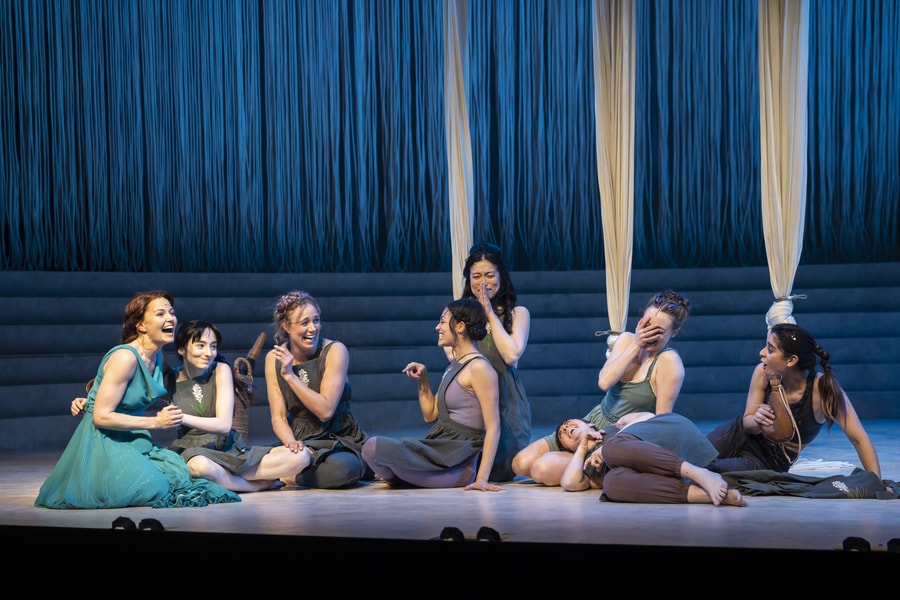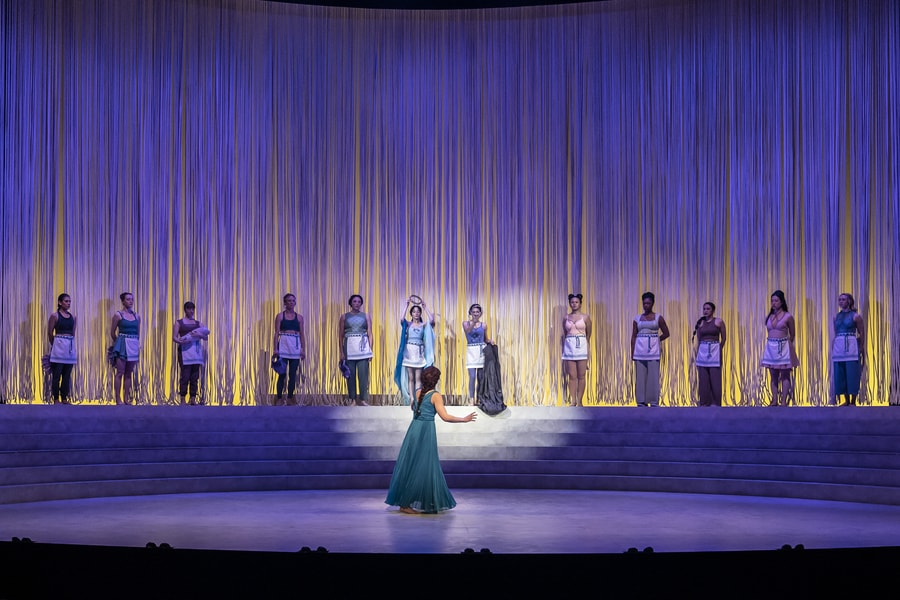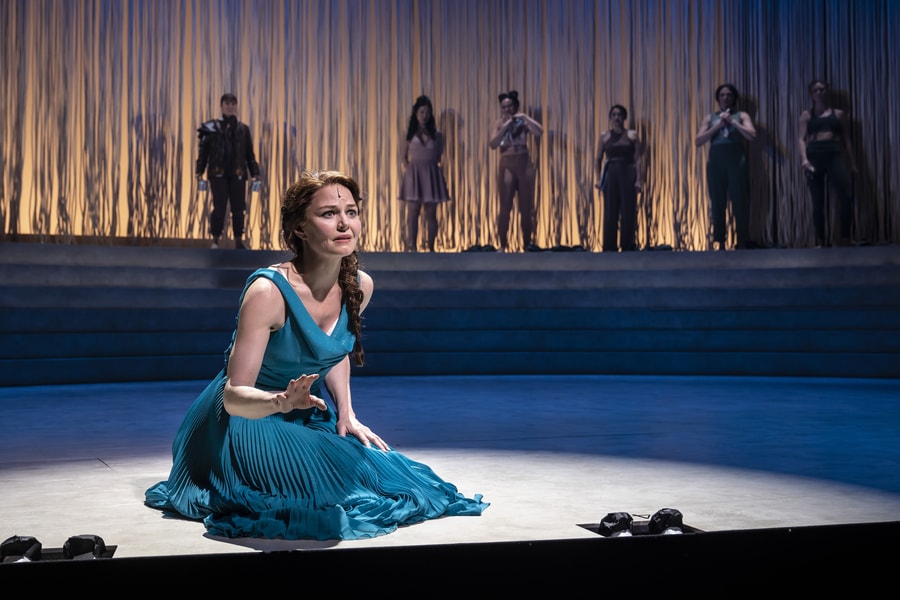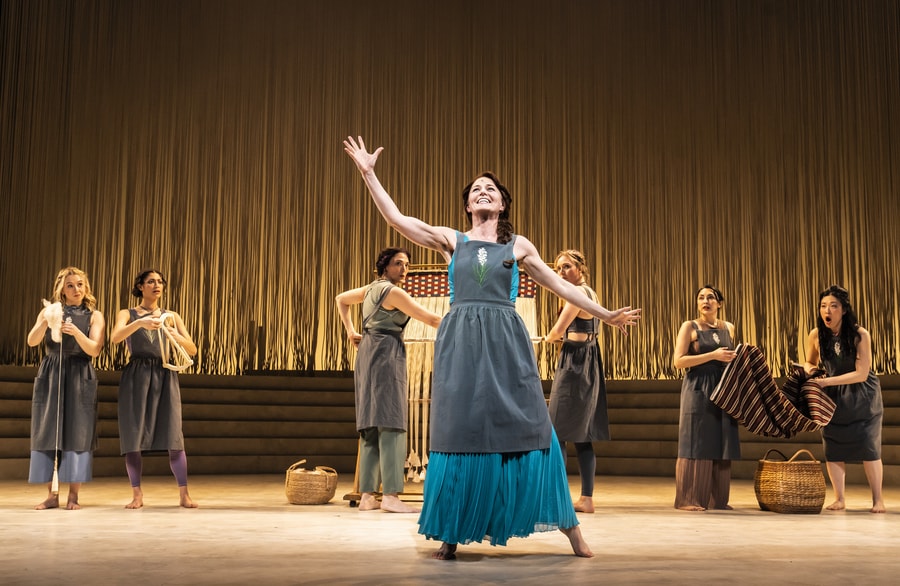Obsessions fuel a writer’s most inspired and joyful prose, even when those obsessions are messy, ugly, painful. That’s certainly true of Margaret Atwood’s work. At the Goodman, performer Jennifer Morrison, known for her work on series House, Once Upon a Time, and film Warrior, lets that buoyancy of Atwood’s vision be her guide around the violent Trojan War.
In Goodman Theatre’s visually operatic, anachronistic The Penelopiad, running through March 31, femme powerhouses in the arena of physical theatre invoke the feminist wit of Atwood’s early poetry and prose. At times, the 2005 novella, which Atwood herself adapted into the theatre piece, eerily overlaps with her 1985 The Handmaid’s Tale, which centers a “handmaid” subjected to state-sanctioned sexual abuse. But The Penelopiad’s primary first-person narrator isn’t a maid in the palace of Odysseus; she is instead the mythologically “loyal” Penelope, who grapples with the consequences of her failure to protect those who mattered most. The result is a compelling new look at Homer’s The Odyssey, with Penelope walking us through her life up until the day her husband returns from Troy and brutally murders the 12 maids who helped her survive and remain chaste—an incident which was practically a footnote in the original. Atwood’s adaptation bridges the complicated relationship among Penelope, the maids, and the audience, and poses a challenge for any experienced performer.
While Atwood’s generation-defining examinations of roles like “wife” and “maid” force us to confront the systematic subjugation of women and complicity of us all, Susan Booth’s surprisingly playful and fluid staging spotlights the 13 impressive femme actors who reflect the rigor and resilience of Chicago storytelling.
I’ve seen almost all the performers in The Penelopiad frequently lighting up the city’s stages, from Congo Square Theatre artistic director Ericka Ratcliff to Demetra Dee, most recently seen in The Nacirema Society. Amid the exciting lineup is Morrison, making a return to the town she grew up in. From seeing shows at the Goodman and Chicago Shakespeare as a child to training with the School at Steppenwolf, Morrison shared in a recent interview how this collaboration has felt like a “dream realized.” Our conversation ranged from geeking out over classics and acting training to the joy of working with Booth, in her first directing project as the Goodman’s artistic director. The following has been edited for concision and clarity.
GABRIELA FURTADO COUTINHO: Between on-screen acting, directing, and your production company Apartment 3c, you’ve been busy with different kinds of processes. Going into this hefty theatrical piece, what has been centering and inspiring you to take on the material?
JENNIFER MORRISON: Every project has inspiration in a different nook and corner. I’m very excited to get back onstage. It really is my first love. It’s how I started and where I feel the most comfortable. It’s very hard to get that to work in my schedule: The stars really have to align, because you have to be right for the role, they have to be interested in you, and then it has to slot into some perfect little window of time where you’re not being pulled somewhere else.
It was very exciting when The Penelopiad came up and was an opportunity for me. I knew I was going to be inspired just by working on Margaret Atwood’s words and what I’d have to tackle. What there was no way for me to know until I got here was how inspired by the entire ensemble and by Susan Booth I’d be. It’s been really special to be in a room for the last month with these women, and I was blown away just by Susan’s vision for the casting. There are 12 women playing 35 roles, and she had to keep in mind that each of those 12 women could be right for their three or four roles. That hasn’t been done before; she’s not following something that already exists. In addition to that, the visual, energetic, and tonal vision she’s had is also just spectacular. I find myself so lit up by every single actor in the ensemble as well as Susan every day.
That must be such a fascinating process too, because it’s not like Margaret Atwood’s work is often staged. Her script doesn’t necessarily define the character breakdown; you can still hear its novella origins. And Susan’s vision involves a uniquely dynamic storytelling, in relation to this traumatic ancient Greek tale. Can you describe your process and preparation, considering the many dramaturgical and physical elements that go into this story?
It’s ironic, because so much of Penelope’s life is about weaving. We reference weaving all the time, and it was weaving a lot of all the things you just mentioned! It was incredibly daunting initially to just look at.
When I record just my lines by myself, it takes 50 minutes to say them all, and that’s without a normal performance pace. At first, the challenge was tackling the mountain of words; I wanted to be accurate and digest properly, because I really want to do right by Margaret Atwood. Once I got past that, it was really looking at the extra information that’s in the novella version of this play to fill in backstory blanks for Penelope. I listened to The Odyssey on tape. Margaret Atwood is so brilliant that her text is just filled with little references to very specific things, both in The Odyssey and mythology in general; it was incredibly informative to go back to that. The references to Hades in mythological texts helped build a visual image of what Hades would look like, at least for how I imagine Penelope experiences it. That was some preliminary stuff.
I had one conversation with Susan before I arrived here to have a sense of the tone she was after, because we both wanted to make sure we were on the same page. I’ve seen clips of this on YouTube where it’s taken very seriously—but I feel this is really funny at times. It’s that Margaret Atwood little wink in the corner of the eye to pull people in and give them a chance to digest some really tough subjects. I think if you don’t have that humor, it’s impossible to digest the tough subjects. You have to figure out how to lean into the wit and the humor first—and weave again.

It has been an incredibly collaborative process of watching the visual unfold next to the text work, and so much of the work in the room has been logistical choreography of the 12 maids who also play all the roles. You will never see anyone but the 13 of us on the stage. There’s just a hugely complex logistical map of how this all works. Susan and the choreographer JoAnn M. Hunter work in such a natural collaboration. The effortlessness, ease, and generosity in how they collaborate overflows into the room.
It was really interesting for me because, in a way, I was in it, but I’m also an observer of it because Penelope is the one telling the story, and they’re the ones showing. I step in and out of the showing with them. In the room, I was able to watch a lot of all of this unfold, and there was this magical ease with which every actor was bringing ideas and so much heart to all of these characters, and Susan would embrace that and then add to it. Then she would offer something, which then they would embrace and add to. I feel it’s been a very idyllic, inspiring way to operate within a collaboration of a large group.
Sounds like a beautiful, very Chicago room. I’m eager to see more of that femme-powered dimension—more reclamation and space-taking. This is the first piece Susan Booth has directed at the Goodman as its artistic director, and I’ve been thinking a lot about the creative lineage of this city and how folks have empowered one another. When you were growing up here, were there people or programs in Chicago you remember inspiring you?
I was very lucky, because I went to a high school that had an incredible arts program. Then I ended up going to Loyola University here in Chicago, and the theatre department there was unexpectedly so perfect for me. I had no idea that it was going to be the perfect place for me on multiple levels. Jonathan Wilson was running the department at the time, Doc Johnson was a very prominent professor, and it was one spectacular person after another there. There were no graduate students at Loyola for theatre, so as an undergrad, you got to be in more theatre. I had no business playing Martha in Who’s Afraid of Virginia Woolf? as my first show in my freshman year; it was terrifying. I’m sure I was awful, but it was an incredible experience for me. It changed me as an actor.
A lot of my inspiration at that time came from my professors, then all my teachers at Steppenwolf. One of the wonderful things about being at their training program was I went the first year that they did it, so it had a lot of attention on it within the company. I got to do 10 weeks of Viewpoints with Tina Landau, and I had a master class with Amy Morton, one with Rondi Reed, one with Jeff Perry. They also brought in Gary Sinise and all these people to do workshop-type classes. You almost can’t put a price tag on those experiences.
Tina Landau, Amy Morton, and Rondi Reed very quickly became real north stars in terms of finding that honesty, diligence in preparation, and the unexpected love I developed for Viewpoints. It really changed the way I approach not just acting, but pretty much everything I’ve done creatively from that point on.
Something I deeply appreciate about Chicago as a theatre town is the joyful rigor, the willingness for folks to be full artists or multi-hyphenates, and the emphasis around learning or sharing types of storytelling. The education piece is really important to me.
Yeah! My dad was the band director at Prospect High School, the music teacher there, and he directed the pit orchestras in shows. That was very special for us every year. My mom would make us a little Ziploc of pretzels or popcorn or whatever little snack and we’d get dressed up and go and watch the high school musical. I just thought it was the most spectacular thing in the whole world. I thought it was incredible the way they were communicating with people and the things that it made everybody feel. It made me so curious about things. And then we would come to the Goodman and see the Christmas show every year. Coming up through school, we would go to Chicago Shakespeare. It really made me aware that this was something you could do for a living.
There are so many full-circle moments in your story. In my own work, I find spiritual life tied to my artistry in part because of these magical coincidences. How would you say your “human practice” informs the art?
I can’t separate my creative self from myself. It’s how I move through the world and communicate. It’s so interesting how that also impacts this particular production, because when the house opens I spend the first 30 minutes sitting onstage. I have to be in relationship with the audience through the whole play. I started to realize in rehearsals that if I just start talking at people suddenly, it’s a lot to digest.
There is this energetic exchange. For me, everything is energy. To be able to sit on the stage, to feel every person walking in the room, to join their energy, to invite them to join my energy is really powerful and helpful for me as we go into this two-hour extravaganza.
That’s especially key with this script because of the intertextuality. Regardless of mythological references and adaptations the audiences bear in mind, there must be the here-and-now immediacy and urgency of feeling. This period of silent onstage presence also primes the audience, I think, for the tragic end we all know is coming. We do get that pre-show breath in Hades and connect with this character—before that playful first act.
Switching gears, what kinds of stories most resonate with you? What specific material do you gravitate toward?
When I was in college, I fell in love with all the classics. We did a lot of O’Neill. My focus was on Shakespeare, which I also miss. And Chekhov, obviously! There’s always that love when you study those classic plays. One we featured in my book club—because we try to do at least one play every year—was Amy Berryman’s Walden, which I really loved. It’s quiet, straightforward, and emotionally powerful, and I really related to it. In general, I feel very drawn to characters who are misunderstood, and that was very clear with Penelope. There’s something powerful about being part of a piece where you’re yearning to be understood, and that’s the engine driving.
Absolutely. In the play, there are so many clear, specific addresses to the audience. I’m interested in the element of misunderstanding “woven” throughout, between Penelope and the maids, between the femme characters and the men in power, between each individual and the audience. There’s much complicated grappling.

I can only imagine how different this modality of storytelling is from your typical film acting. How would you describe your experience transitioning between theatre and TV/film, or vice versa?
I really attribute my ability to do that to Mark Rydell, who directed Intersection. I was 13, and I had done theatre at school and in weekend programs, as well as commercials. He saw I had it in me through the audition process and that I was going to work really hard to figure it out. But everything I was doing was too big. He was really my first acting teacher for on-camera thought process. I remember him saying, “If you think it, I can see it. Just don’t do anything. Just think the right things.”
That took a tremendous amount of restraint at that age. I’m also a very expressive person naturally. I could never be on-camera as big as I am in real life with my gestures and facial expressions—who I am is big. I started really just paying attention to performances on-screen and realizing how restrained and small they were; how simple camera acting was. I did a couple films in my teenage years, then in college. I realized the training and thought process got me to have more confidence when I stepped on a set. And you never stop learning that stuff. That’s an ongoing process. You never stop gaining new muscles.
There’s much to be learned on an individual and industry-wide level. When there’s significant change in both theatre and TV/film worlds, I think, people have to develop even more agility and resilience. Especially to young people coming up in this uncertain time for entertainment, what advice or hope would you impart on navigating those intricacies?
It’s a really tricky time, and it’s ironic advice coming from someone playing Penelope, but I would say you need patience right now. We’re not in a time that reflects any of the lore of theatre, television, and film, these ideas in our head of what it means to “make it.” That isn’t a thing anymore the way that it was. You have to let go of expectations and really challenge yourself to consider whether you’re in it because you really love it and want to tell stories, or whether you’re in it because you want to feel special about “making it.” Those are two very different things. There’s less and less space for the accidental “making it” thing. There are fewer projects, fewer opportunities, fewer everything. It’s going to be harder and more arduous. If you’re waiting to get your value from someone else selecting you, you’re going to be devastated.
In addition to that, I would just say you have to keep trying. You can’t get beaten down by the word “no.” You don’t know when it is going to be your job. You have to be ready when it is yours. That might be the 50th audition, that might be the 1,000th audition. You don’t know. But you have to have the endurance to get to the 1,000th audition if that’s what is required. You can’t go in with rose-colored glasses.
I do hope that in the next year or two things will start to settle down a little bit. But it’s not going to be tomorrow, and it’s not going to be in a month from now. It’s going to take time for the industry to adjust to what the new norms are.
Thank you for that. Thinking about your own experience of ongoing learning, what have you gleaned from this process of The Penelopiad and being back onstage in Chicago?
On a very practical level, I completely reworked how I memorize because of the sheer volume of words and because of how Margaret Atwood writes. I’ve always been a fast memorizer, but the specificity and cadence is so different. There’s almost no room to have a slight variation; it doesn’t work with heightened text. Every word is on purpose. Every time I would trip over a section in my memorizing process, I would realize it was because I had missed an intention. I have always done a combination of writing my lines over and over again, and then I also would record them to listen and subliminally get them in me.
But this time, I started memorizing from the start of a sentence to the middle of the next sentence. And then I would double back at the start of a sentence and go to the middle of the next sentence. I kept leapfrogging because the way that Margaret tells a story is not from A to B. You go from A to H to Z to B to D back to Z; it’s a zigzag, and you have to map it. This process meant I was never losing the transition into the next sentence in my mind. If you get out there and want to hit a new inflection or make a point differently, it has to be in your muscle memory so deeply.
What are you looking forward to after this project concludes? Any plans to return to Chicago theatre?

I would love to do more theatre. It all has to balance out properly. There are a couple directing projects that are on the horizon, so I’m going to see where those things fall, but I hope this is the beginning of a great relationship with Susan and the Goodman. I hope there are other projects down the road that I could come back to be a part of. Like I said, I trained at Steppenwolf, and I have a great admiration for the productions that they put up. When I can make it work and plan around it, I would be thrilled to spend as much time as possible onstage in Chicago. This has just been an incredible experience creatively. I’m really honored to be here. It really has felt like a childhood dream realized to be on this particular stage.
Gabriela Furtado Coutinho (she/her) is the Chicago associate editor of American Theatre.


